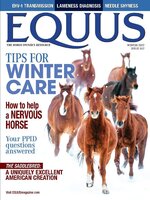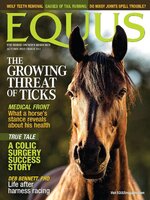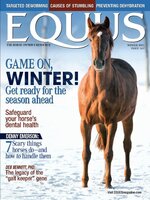EQUUS provides the latest information from the world's top veterinarians, equine researchers, riders and trainers on understanding and influencing equine behavior, recognizing the warning signs of illness and disease, and solving riding and training problems.
Equus
The HOWS and WHYS of equine vaccination • Here’s a refresher on how vaccines work and factors to consider when devising a plan to protect your horse from disease.
CORE VACCINES
RISK-BASED VACCINES
7 myths about EQUINE NUTRITION • To help you ensure that your horse’s diet meets his needs, we debunk common—and persistent—horse-feeding myths.
4 WAYS TO KEEP YOUR HORSE FROM GETTING FAT
The right approach to PARASITE CONTROL • It’s more important than ever to target deworming treatments, time administration of anthelmintics appropriately and take measures to limit your horse’s exposure to internal parasites.
THE ARSENAL: DEWORMING AGENTS
THE TARGETS: INTERNAL PARASITES AFFECTING HORSES
The DOS AND DON’TS of managing for healthy joints • Reduce your horse’s risk for arthritis and other joint problems by following these commonsense guidelines.
6 RULES FOR KEEPING YOUR HORSE SOUND
Manage your horse for DIGESTIVE HEALTH • Diet and lifestyle can affect a horse’s risk for ulcers, colic and other digestion-related problems. How “gut-friendly” is your horse’s current management routine? Answer the following 5 questions to find out.
ULCER DIAGNOSIS AND TREATMENT
PROBIOTICS AND PREBIOTICS
FIRST RESPONSE • When your horse has an illness or injury, the first steps you take can have a significant impact on his recovery. Here are guidelines for what to do—and to avoid—when your horse is injured, ill or in distress.
Laminitis • The moment your horse begins to show signs of this devastating hoof disease, take quick action to slow its progress and reduce the extent of the damage.
Colic • Call your veterinarian at the first signs of abdominal pain—but as you wait, take steps to keep your horse comfortable and prevent his condition from getting worse.
Heaves flare-up • When your horse has to work to breathe, call the veterinarian—then take steps to make him more comfortable.
Large laceration • When you find your horse with a large, bleeding wound, summon help and then take steps to lay the groundwork for healing.
Choke • When your horse develops an obstruction in his esophagus, doing the wrong thing can turn a relatively minor event into a potentially life-threatening problem.
Scratches • Pasterns often become crusty and scabby when “mud season” turns paddocks into soupy messes. But left untreated, a simple case of scratches can escalate into a painful, chronic condition.
Heat exhaustion • When temperatures are soaring and humidity is high, even normal activities can cause a horse to become dangerously overheated. If that happens, you’ll need to take quick action to save his life.
Runny nose • Take a few minutes to make sure your horse’s sniffles are a harmless nuisance rather than a sign of serious illness.
Rainrot • With a few simple steps at the first signs of trouble you can keep this generally minor skin infection from growing out of control.
Loose shoe • Schedule a visit with your farrier as soon as you notice a loose shoe. But in the meantime, you’ll want to take steps to either keep it in place or remove it.
Tying up • If your horse develops severe muscle cramping, call your veterinarian, then keep him still and comfortable until help arrives.
Fly spray myths debunked • Here’s the scoop on four common misconceptions about one of the biggest challenges of summer horsekeeping—keeping bugs at bay.

 Spring 2025
Spring 2025
 Winter 2024
Winter 2024
 Fall 2024
Fall 2024
 Summer 2024
Summer 2024
 Spring 2024
Spring 2024
 Winter 2023
Winter 2023
 Fall 2023
Fall 2023
 Wellness 2023
Wellness 2023
 Summer 2023
Summer 2023
 Spring 2023
Spring 2023
 Winter 2022
Winter 2022
 Fall 2022
Fall 2022
 Wellness Issue 2022
Wellness Issue 2022
 Summer 2022
Summer 2022
 Spring 2022
Spring 2022
 Winter 2021
Winter 2021